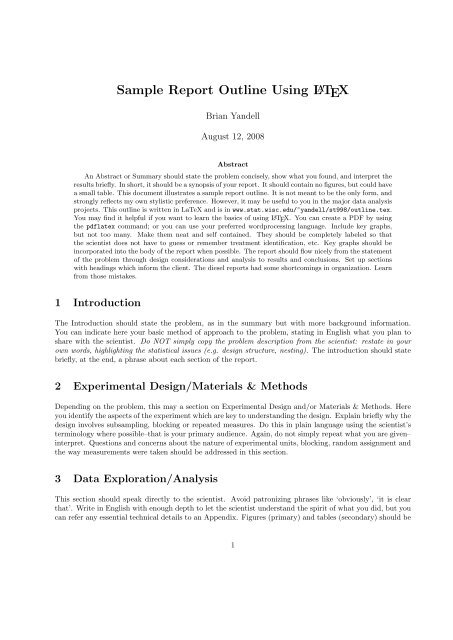Sample Report Outline Using LATEX
Sample Report Outline Using LATEX
Sample Report Outline Using LATEX
You also want an ePaper? Increase the reach of your titles
YUMPU automatically turns print PDFs into web optimized ePapers that Google loves.
<strong>Sample</strong> <strong>Report</strong> <strong>Outline</strong> <strong>Using</strong> L A TEX<br />
Brian Yandell<br />
August 12, 2008<br />
Abstract<br />
An Abstract or Summary should state the problem concisely, show what you found, and interpret the<br />
results briefly. In short, it should be a synopsis of your report. It should contain no figures, but could have<br />
a small table. This document illustrates a sample report outline. It is not meant to be the only form, and<br />
strongly reflects my own stylistic preference. However, it may be useful to you in the major data analysis<br />
projects. This outline is written in LaTeX and is in www.stat.wisc.edu/~yandell/st998/outline.tex.<br />
You may find it helpful if you want to learn the basics of using L A TEX. You can create a PDF by using<br />
the pdflatex command; or you can use your preferred wordprocessing language. Include key graphs,<br />
but not too many. Make them neat and self contained. They should be completely labeled so that<br />
the scientist does not have to guess or remember treatment identification, etc. Key graphs should be<br />
incorporated into the body of the report when possible. The report should flow nicely from the statement<br />
of the problem through design considerations and analysis to results and conclusions. Set up sections<br />
with headings which inform the client. The diesel reports had some shortcomings in organization. Learn<br />
from those mistakes.<br />
1 Introduction<br />
The Introduction should state the problem, as in the summary but with more background information.<br />
You can indicate here your basic method of approach to the problem, stating in English what you plan to<br />
share with the scientist. Do NOT simply copy the problem description from the scientist: restate in your<br />
own words, highlighting the statistical issues (e.g. design structure, nesting). The introduction should state<br />
briefly, at the end, a phrase about each section of the report.<br />
2 Experimental Design/Materials & Methods<br />
Depending on the problem, this may a section on Experimental Design and/or Materials & Methods. Here<br />
you identify the aspects of the experiment which are key to understanding the design. Explain briefly why the<br />
design involves subsampling, blocking or repeated measures. Do this in plain language using the scientist’s<br />
terminology where possible–that is your primary audience. Again, do not simply repeat what you are given–<br />
interpret. Questions and concerns about the nature of experimental units, blocking, random assignment and<br />
the way measurements were taken should be addressed in this section.<br />
3 Data Exploration/Analysis<br />
This section should speak directly to the scientist. Avoid patronizing phrases like ‘obviously’, ‘it is clear<br />
that’. Write in English with enough depth to let the scientist understand the spirit of what you did, but you<br />
can refer any essential technical details to an Appendix. Figures (primary) and tables (secondary) should be<br />
1
well-annotated, self contained, and tell a major portion of the story. Figures in such a report should include<br />
elements of analysis (such as regression lines, error bars, etc.).<br />
This section should state what you found and how you found it (sometimes it is useful to do this in two<br />
sections). It should be organized to tell the story you finally uncovered, not the circuitous path you took to<br />
get there. ANOVA tables may or may not be important. Think hard about what to include and what can<br />
be left out. Keep it simple.<br />
Ask yourself if you really need an Appendix (mine was taken out years ago). Keep it neat; make it self<br />
contained. The Appendix, if needed, you can be more technical.<br />
4 Roles and Responsibilities<br />
[This is not a report section, but a comment on the consulting process.] There is no right answer to most<br />
real problems; however, your report should have enough detail that another statistical consultant could<br />
figure out what you did and (largely) reproduce it. Remember that as a consultant one of your roles is being<br />
an educator. Teach the scientist good organization and reasoning skills; these are far more important than<br />
fancy technical tools. You are also an artist, and will learn best by practice and apprenticeship. Take charge<br />
of your learning; find out about the resources at your disposal, including me, the computer and the library.<br />
Your own mistakes are also a fundamental part of this process.<br />
5 Conclusion<br />
The concluding section should restate the results in a concise fashion, in different words and more depth<br />
than the summary. Refer back to the key questions posed by the scientist and tie these to the results. The<br />
conclusion looks back over the experiment and analysis, and can raise questions and suggestions about future<br />
investigations. Include here ideas you have about future design considerations. The scientist may not be able<br />
to collect more data, or more precise data, due to costs and other considerations; keep this in mind when you<br />
make recommendations. Remember to respect the scientist throughout, but especially in the conclusions.<br />
Interpretation of design and results can appear throughout the report. However, people tend to read the<br />
Summary and Conclusion first, glancing at the figures and tables. Later attention is given to the body of<br />
the report–provided the parts they read caught their interest.<br />
2

















